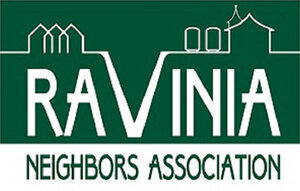History of Ravinia
By Elliott Miller
Before the European-American settlers arrived in our area, Potawatomie Indians foraged for food from their hunting camp located on the high ground north of Clavey Road. Many woodland creatures—deer, timber wolves, lynx, and even the now rare Eastern Massasauga Rattlesnake were plentiful in those days.
Western settlement began in the 1840s with the arrival of English and German immigrants who sought a new life in the wilds of northern Illinois. The huge oak and maple trees, thin topsoil, and irregular terrain made the land along the western shore of Lake Michigan undesirable for agriculture, so life was hard for those who wanted to farm the land. But the natural landscape, proximity to the lake, and the introduction of the railroad made the north shore a desirable location for country homes and full-time settlement.
In April of 1872, a group of real estate investors and developers met to plat the section of land located south of newly incorporated Highland Park. Headed by Benjamin Franklin (B.F.) Jacobs, who was a Chicago real estate developer and prominent member of the Baptist movement, the group wanted to establish a community in a healthy countryside setting away from the grime of Chicago. They named streets after prominent Baptist missionaries who risked their lives traveling to the Far East; and they called the community "Ravinia," after the numerous steep-sided ravines that sliced the land. They named the main commercial street after Roger Williams, who rebelled against the rigidity of the Puritans of Massachusetts colony and founded Providence, Rhode Island as a shelter for those who were oppressed for conscience.
B.F. Jacob's community failed as a result of an untimely economic downturn and lack of basic infrastructure that communities need. The area was consequently annexed by Highland Park in 1899; but the still-wild landscape continued to attract people who loved nature. The Ravinia Opera Festival, which ran from 1911 to 1931, was also a great attraction for people who loved the fine arts. By 1904, an artist colony began to form and, until 1940, many artists, writers, poets, and musicians lived in rustic cottages along the wooded lanes and ravine edges. The mass influx of people from Chicago after WWII lead to the suburbanization of the area.
Today, the small shops on Roger Williams Avenue are reminiscent of the past and herald the future. Living "over the store" is an old idea that is returning. The proximity of the beautifully restored train station to the business district, three parks, and Ravinia Music Festival creates harmonious residential and business conditions and opportunities for the future.
The process of improving the streetscape, restoring and enhancing the landscapes, friendlier streets with benches, bike racks, and plantings, is well under way.
Longer term, enhancements and diversification of the retail mix will yield a business district similar to Market Square in Lake Forest, Hubbard Woods in Winnetka, or Glencoe's downtown. Maximizing greenspace, allowing pedestrian walkways, improving parking, and insuring smooth traffic flow can be achieved by working closely with city government, commissions, park district, developers, and local businesses.
Developers are encouraged to be mindful of Ravinia's history: it's architecture, the craftsman style original buildings of Ravinia Festival, the restored train station, and the historic landscaping of Jens Jensen Park ... all of these should set the tone for future projects.
A decade ago, Ravinia neighbors and city staff and consultants completed a strategic plan, conceived and completed the Ravinia Strategic Plan. An early project under the plan, the Walgreens building, followed the spirit of that plan. An important second step ensured that the development of Ravinia Park Place as a modern structure with traditional elements that beautify and enhance the neighborhood. This was followed by the condominium structure at the NE corner of Green Bay Road and Roger Williams Avenue.
The Ravinia Neighbors Association works to enhance, improve, and beautify our village–to ensure a Ravinia we are proud to call home.
